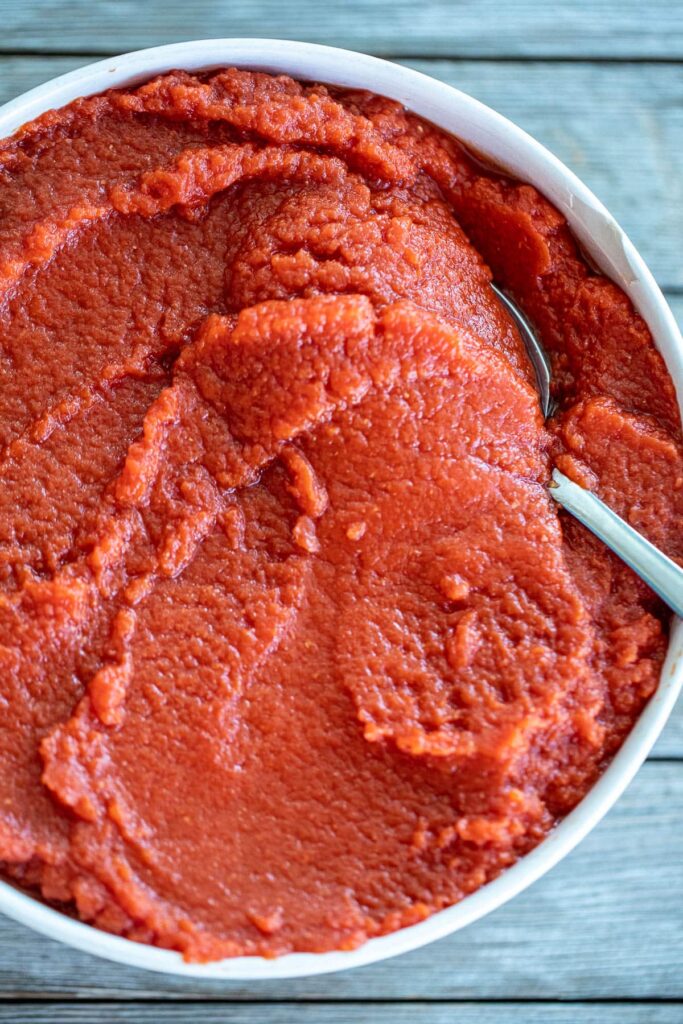Store Bought:
Regional differences
In the UK, tomato paste is also referred to as concentrate. In the US, tomato paste is simply concentrated tomato solids (no seeds or skin), sometimes with added sweetener (high fructose corn syrup), and with a standard of identity (in the Code of Federal Regulations, see 21 CFR 155.191). Tomato purée has a lower tomato soluble solids requirement, the cutoff being 24%. For comparison, typical fresh round tomatoes have a soluble solid content of 3.5–5.5% (refractometric Brix), while cherry tomatoes have double the amount.
Diabetic Tomato Paste
Homemade tomato paste is an entirely different — and utterly more delicious — beast than the kind you can buy at the supermarket. It takes about a day to make (happily, much of that work is hands-off), and in the end, you’ll have enough tomato paste to last you through several cooking projects. In this recipe, you’ll only need four ingredients and you’ll go through a process that includes passing the tomatoes through a food mill and baking the tomato pulp until reduced to paste.Use a food mill, sieve, or chinois to separate the tomato pulp from the seeds and skins.As you bake the tomato pulp, the paste will reduced by more than half and it will look shiny and brick-colored.Portion the finished paste into ice cube trays, freeze, and then bag and label.Storing Diabetic Tomato Paste The recipe below gives directions for boil-water canning this tomato paste, but if you’d like to take the easy way out, portion the finished paste into ice cube trays, freeze, and then bag and label the frozen cubes. Anytime you need just a small amount of tomato paste, pull out a cube. These cubes can be frozen for up to nine months.San Marzano tomatoes can be part of a healthy diet for people with diabetes because they are low in carbs and sugar, and contain nutrients that can help regulate blood sugar: Low in carbs: San Marzano tomatoes have minimal impact on blood sugar levels. Nutrients: Tomatoes contain chromium, which helps regulate blood sugar, and lycopene, which may help protect against heart disease, high blood pressure, and strokes. Tomatoes are also rich in vitamin C and potassium, which can support heart health and the immune system. Non-starchy: Tomatoes are considered non-starchy, which makes them a good choice for people with diabetes. San Marzano tomatoes are a type of plum tomato, which are dense and meaty with less juice and seeds than other types of tomatoes. They are often used for cooking sauces, pastes, and other dishes.
Print
Pin
Rate
Equipment
- Chef’s knife
- Cutting board
- Large pot
- Food mill, sieve, or chinois
- 2 rimmed baking sheets or 1 roasting pan
- 4-ounce jars, for storing
Ingredients
- 10 pounds San Marzano tomatoes
- 2 tablespoons olive oil
- 2 teaspoons sea salt
- 1/2 teaspoon citric acid or 2 tablespoons bottled lemon juice
Instructions
- Preheat the oven to 350°F. Arrange 2 racks to divide the oven into thirds and heat to 350°F.
- Chop tomatoes into quarters. Quarter the tomatoes.
- Simmer the tomatoes with the olive oil. Place the olive oil in a large pot over medium-high heat until shimmering. Add the tomatoes and cook until soft and the peels begin to detach from the tomato flesh.
- Pass the tomatoes through a food mill. Push the warm tomatoes through a food mill, sieve, or chinois to separate the tomato pulp from the seeds and skins. Stir the sea salt and citric acid or lemon juice into the pulp. Discard or compost the seeds and skins.
- Place the pulp on 2 baking sheets. Divide the tomato pulp between 2 large, rimmed baking sheets. You can also use a large roasting pan, but it will take longer to cook down that way.
- Bake the tomato pulp until reduced to a paste. Place the baking sheets in the oven. Check the tomatoes every half hour, stirring the paste and switching the position of the baking sheets so that they reduce evenly. Over time, the paste will start to reduce to the point where it doesn’t fill the baking sheet any more. At this point, combine the contents of the two baking sheets into one and continue to bake.
- Bake until reduced by more than half. The paste is done when shiny, brick-colored, and reduced by more than half, 3 to 4 hours, though exact baking times will depend on the juiciness of your tomatoes. There shouldn’t be any remaining water or moisture separating from the paste at this point.
- Transfer the paste into jars. Divide the finished paste into 4-ounce jars, leaving 3/4-inch headspace.
- Preserving Option 1 — Process the tomato paste in a hot water bath. Apply lids and rings and process in a boiling water bath for 15 minutes. Keep in a cool, dark place for up to 1 year. After opening, refrigerate for up to 1 week.
- Preserving Option 2 – Refrigerate or freeze. If you don’t want to process the paste, you can refrigerate or freeze it instead. Scrape finished paste into clean half or quarter pint jars. Top each jar with a layer of olive oil and place in either the refrigerator or the freezer. As long as you keep it well-covered with olive oil and ensure that you only use a very clean spoon to remove it from the jar, it will keep in the fridge for 3 to 4 weeks. Frozen, it will keep for up to 9 months.
